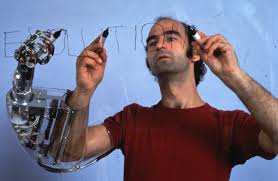Apr 05, 2015
Are you concerned about AI?
Recently, a growing number of opinion leaders have started to point out the potential risks associated to the rapid advancement of Artificial Intelligence. This shared concern has led an interdisciplinary group of scientists, technologists and entrepreneurs to sign an open letter (http://futureoflife.org/misc/open_letter/), drafted by the Future of Life Institute, which focuses on priorities to be considered as Artificial Intelligence develops as well as on the potential dangers posed by this paradigm.
The concern that machines may soon dominate humans, however, is not new: in the last thirty years, this topic has been widely represented in movies (i.e. Terminator, the Matrix), novels and various interactive arts. For example, australian-based performance artist Stelarc has incorporated themes of cyborgization and other human-machine interfaces in his work, by creating a number of installations that confront us with the question of where human ends and technology begins.

In his 2005 well-received book “The Singularity Is Near: When Humans Transcend Biology” (Viking Penguin: New York), inventor and futurist Ray Kurzweil argued that Artificial Intelligence is one of the interacting forces that, together with genetics, robotic and nanotechnology, may soon converge to overcome our biological limitations and usher in the beginning of the Singularity, during which Kurzweil predicts that human life will be irreversibly transformed. According to Kurzweil, will take place around 2045 and will probably represent the most extraordinary event in all of human history.
Ray Kurzweil’s vision of the future of intelligence is at the forefront of the transhumanist movement, which considers scientific and technological advances as a mean to augment human physical and cognitive abilities, with the final aim of improving and even extending life. According to transhumanists, however, the choice whether to benefit from such enhancement options should generally reside with the individual. The concept of transhumanism has been criticized, among others, by the influential american philosopher of technology, Don Ihde, who pointed out that no technology will ever be completely internalized, since any technological enhancement implies a compromise. Ihde has distinguished four different relations that humans can have with technological artifacts. In particular, in the “embodiment relation” a technology becomes (quasi)transparent, allowing a partial symbiosis of ourself and the technology. In wearing of eyeglasses, as Ihde examplifies, I do not look “at” them but “through” them at the world: they are already assimilated into my body schema, withdrawing from my perceiving.
According to Ihde, there is a doubled desire which arises from such embodiment relations: “It is the doubled desire that, on one side, is a wish for total transparency, total embodiment, for the technology to truly "become me."(...) But that is only one side of the desire. The other side is the desire to have the power, the transformation that the technology makes available. Only by using the technology is my bodily power enhanced and magnified by speed, through distance, or by any of the other ways in which technologies change my capacities. (…) The desire is, at best, contradictory. l want the transformation that the technology allows, but I want it in such a way that I am basically unaware of its presence. I want it in such a way that it becomes me. Such a desire both secretly rejects what technologies are and overlooks the transformational effects which are necessarily tied to human-technology relations. This lllusory desire belongs equally to pro- and anti-technology interpretations of technology.” (Ihde, D. (1990). Technology and the Lifeworld: From Garden to Earth. Bloomington: Indiana, p. 75).
Despite the different philosophical stances and assumptions on what our future relationship with technology will look like, there is little doubt that these questions will become more pressing and acute in the next years. In my personal view, technology should not be viewed as mean to replace human life, but as an instrument for improving it. As William S. Haney II suggests in his book “Cyberculture, Cyborgs and Science Fiction: Consciousness and the Posthuman” (Rodopi: Amsterdam, 2006), “each person must choose for him or herself between the technological extension of physical experience through mind, body and world on the one hand, and the natural powers of human consciousness on the other as a means to realize their ultimate vision.” (ix, Preface).
23:26 Posted in AI & robotics, Blue sky, ICT and complexity | Permalink | Comments (0)







The comments are closed.